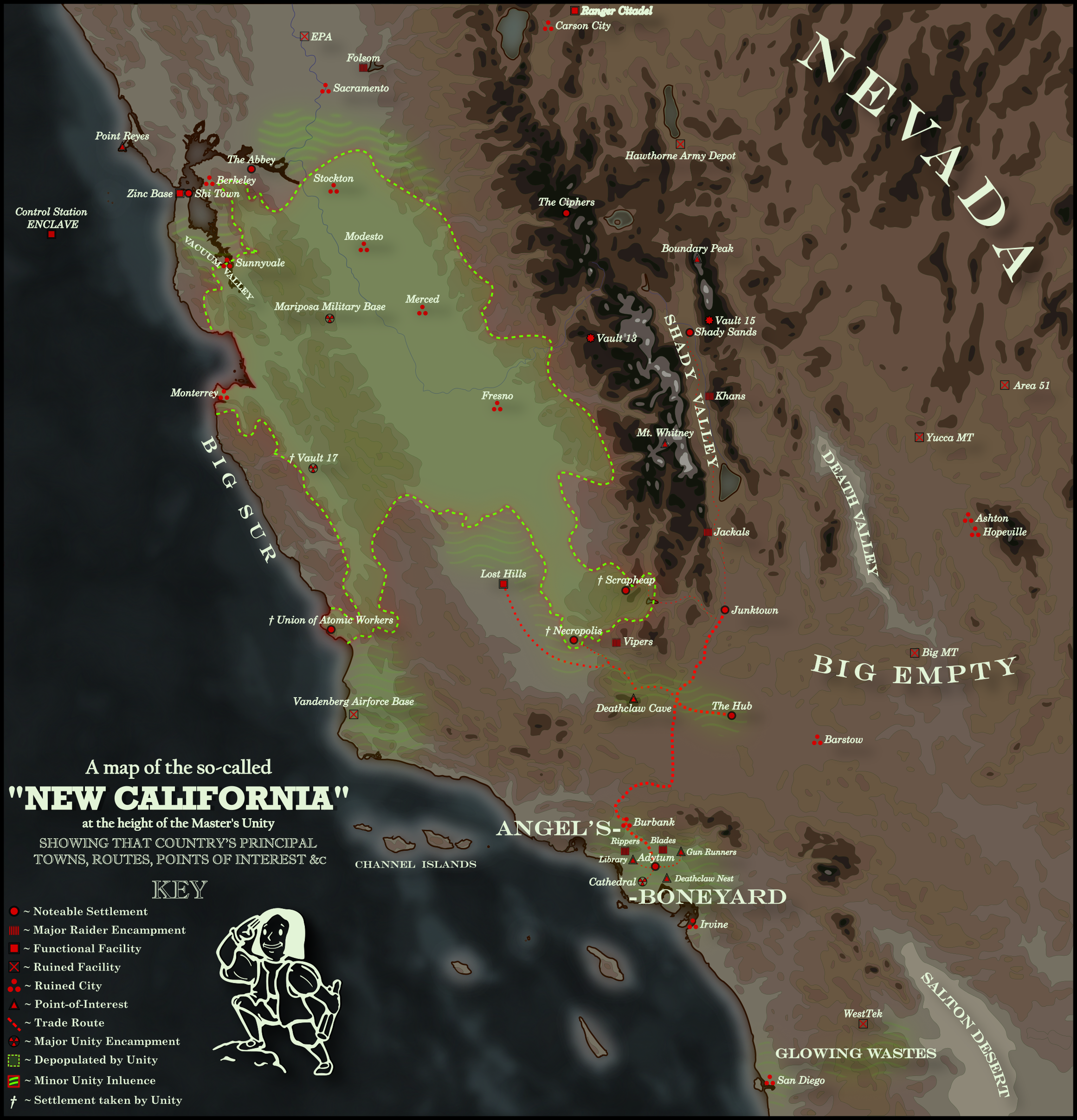Map of the Unity at its Height
www.youtube.com/watch?v=dn3UDy…
Civilization in the Central Valley of California was strangled in its cradle. In the time before, when California sprouted great cities of pipe and steel, the valley was the breadbasket of the West, a vast plain fruited with every delicious thing. It was a teeming garden whose cultivation drove America forward. Then came the end. Black and orange trees sprouted on the horizon, wheat waved in spreading fire. Torrents of black burning rain came down, drowning great cities.
These things the Central Valley shared with much of the world. But there was one fact of its form that set it apart from much of the world. Shaped as a great bowl, in the 20th century the valley was beset by choking smog, unable to escape over California's vast mountains. And after the War, the Central Valley became a great pool of irradiated fallout in its air. Radiation cycled out more slowly here than it did elsewhere, in turn slowing the regrowth of plant life. The soil eroded, kicking up great storms of radioactive sand and dirt. The Central Valley of California became a vast desert, an irradiated dustbowl.
Mutants were a constant threat. The festering fallout of the War and the rotting hearts of old-world cities conspired to create untold horrors. This would be bad enough if it were not for an ancient ruin towards the center of the great valley, leeching a strange brew into the soil and water table around it, accelerating the rate of mutation.
Progress was slower here than it was in southern California, yet there progress there was. Farmsteaders clung to the banks of the San Joaquin and the Sacramento, grim butchers of men and mutants made their savage living. Ingenious tule-eaters huddled in vast mud flats, the shambling horrors of the Necropolis eked out a living. Metallic monks occulted themselves in study, motorbiking nomads ranged the sand dunes around Sacramento. The agricultural poverty of the valley was dampened the attraction of interaction for the budding societies of southern California, but some enterprising individuals still crossed the Tehachapi mountains to make contact and conduct commerce. As the years wore on, higher levels of trade and development were frustrated by vast populations of mutants. It was a seeming paradox - as time wore on, when the rest of the world healed and returned to something resembling normal, the creatures of the Central Valley grew stranger and more hostile. The caravan masters of the rising Hub, hearing tales of a dark heart of corruption in the north, resolved to send an expedition to solve this problem...
The southerners never received an answer to their question. It became just one more of the countless mysteries in the new world. Life went on, things grew and changed. Populations grew in the south.
In the Owens Valley, soon to take the name of the Shady Valley, rivers and lakes were filled for the first time in centuries, freed from the thirst of old Los Angeles. Farming villages sprouted, inevitably attracting predators - the savage Khans, the degenerate Jackals, among many others. The ranchers of Junktown encamped towards the mouth of that valley and the Isabella Valley, serving as an entrepôt between those agrarian communities and the bustling Hub.
To the west of the Hub was was vast desert. Despite tales of lost cities and mountains inhabited by gods, the people of the Hub knew it only to be inhabited by gecko-eating savages, a big empty nothing. They were more interested in the lands in the further south. The L.A. Boneyard stretched forever, the skeletons of buildings lying under the hot sun. Soils composed of crumbled concrete and shattered glass proved inhospitable to agriculture, and yet it was replete with clans who made their living by hunting on the one hand, and scavenging on the other. Not so much for advanced technology and finished products, though there was a lucrative trade in these, but for raw materials - steel, chiseled stone, copper wire, glass, all of this could go for a fortune. Some ingenious gangs turned these raw materials towards manufacturing. It was a violent and desperate place, replete with blood and horror, but even here there was hope.
Down the broken coast, past the looming re-purposed old world Cathedral, there was little of note. There were strange rumors on the banks of Irvine - a colony of thinking mutants, a city of robots, a pristine office building from the old world, but these were just rumors. The land grew more hostile the further south you went and the inhabitants more debased until you were met the triple-desolation of old San Diego, the Glowing Wastes, and the bone-strewn Salton Desert.
Back to the north, there were fisher clans and raiders up to the Modoc Valley, where still glowed in the night. Vandenberg Airforce, destroyed first in the War, and a second time in conflict by the Union of Atomic Workers. The Union, based in Diablo Canyon Nuclear Power Plant, was one of the most technologically advanced societies in the wasteland, and yet they were even more committed to isolation than the Brotherhood to the east. Just as they had destroyed Vandenberg in conflict, they would be destroyed by the arrival of the Mutant Army, their advanced technology pilfered, their cooling towers shattered, a bare remnant surviving in hidden tunnels beneath the earth.
It was a common story. Ever year, another wave of settlements went dark, supposed destroyed by hunger and mindless mutants. The Salter people of the Salinas Valley were annihilated, the Vault and settlement at King City turned to one of history's greatest horrors - just one of many vaults cracked open for its Prime Normals. The scavengers of Scrapheap fled in the night when sentries saw the mutants coming. The Yakuza of San Francisco attempted to stem the evil at its source, and lost their home for it. The Tule-Eaters, the ghouls of Necropolis, the Army of God, the Camper Clans, the Glass Walkers. Most of the peoples destroyed by the Unity would be lost to history, their names never uttered again. They fled to the four corners, coming to new lands and mountain holdfasts. Mostly, they starved, they fell prey to beasts and raiders, they became raiders themselves, they were absorbed into other peoples.
The number of trade routes drawing merchants to the central valley declined to a bare handful. When Necropolis and Scrapheap went dark, there was only one left of note. Few in the south knew the true nature of the looming threat beyond Tejon Pass, and the undermining influence of a strange new cult. The coming conflict would determine not only the fate of California, but perhaps the world...
--------------------------------------------
The basic idea of this started with the idea I had in my head that the Super Mutant expansion would end up being something like the Mfecane, depopulating the central valley and spawning waves of migration and conflict. It ended up becoming more of a bog-standard Fallout 1 era map, but I'm pretty happy with how it came out.
One thing I'm not entirely happy with is how the topography came out. If anyone has any recommendations to spruce this up going forward, let me know.




